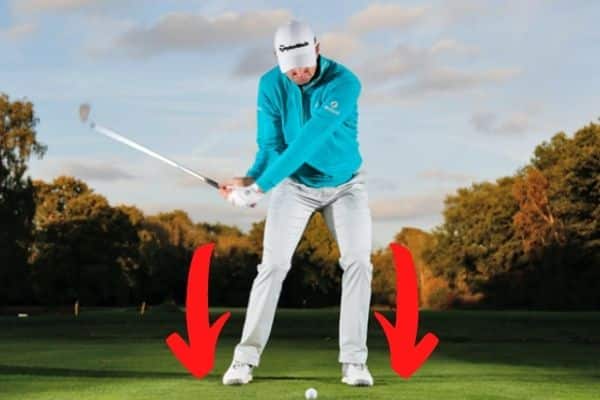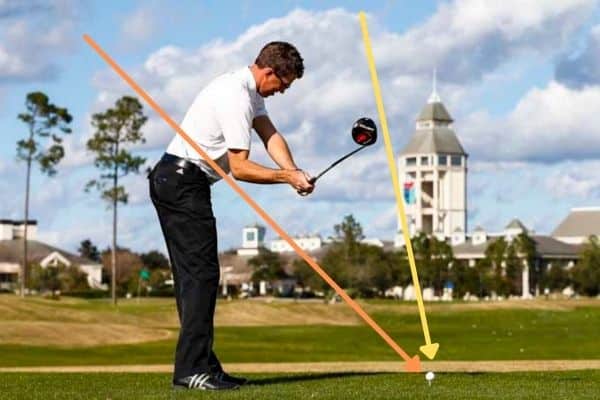Coming over-the-top is a term often bandied around in the game of golf.
It refers to a swing where the downswing occurs on a steeper plane than the backswing, often causing slices (rather than a nice, gentle fade).
The action is incredibly common in amateur golfers who have been unable to master the action of laying off or shallowing the golf club, as well as people who swing with real stiffness and tension in their arms.
The action involves the arms and shoulders actively throwing the club towards the ball in a steep downswing motion, rather than letting the club drop in behind and return to the ball on a shallower plane than what it started on.
Ultimately, this action leads to an out-to-in club path, causing slices, but sometimes even pulls or duck hooks if the clubface is shut through impact.
So, how do you stop coming over-the-top in your golf swing?
To stop coming over-the-top, you need to work on shallowing the golf club in the downswing. This involves developing a more relaxed, tensionless feeling at the top of the backswing. Using alignment sticks to direct club path can also offer real-time feedback as to whether your action is, in fact, over-the-top.
Let’s spend some time breaking down the key reasons people come over-the-top and how you can go about eradicating this annoying habit.
Table of contents
What causes coming over-the-top in the golf swing?
In essence, an over-the-top swing comes about due to an overuse of the upper body when playing a shot. Typically, the plane of the club in the downswing is steeper than, or over-the-top of, the plane of the club in the takeaway, leading to slices if the clubface is open, or pulls if the clubface is shut.
Now, most people aren’t deliberately trying to make this motion; rather, key underlying factors lead to people feeling more comfortable bringing the club down to the ball in this manner, rather than with a shallower shaft angle.
Your over-the-top action most likely boils down to one of the three key issues below.
Issue #1: Poor hip mobility
If your flexibility isn’t up to scratch, there’s a good chance that your upper body and arms will be more active in the golf swing.
Your hips should perform rotation as the club moves around the body as well as upwards, not just straight up in the air to your top position.
If you lack flexibility and find it challenging to rotate, it’s likely that you are bringing the club straight up into a steep position and bringing it down on a similar, or steeper plane as this feels comfortable for your body.
A warm up routine may be helpful, so consider using a foam roller or pressure point ball to loosen hip tension before working on your rotation.
Issue #2: Poor weight shift
Transferring weight between the front and back foot throughout the golf swing is crucial in allowing the club to drop into a shallowed position in the downswing, avoiding an over-the-top shot.
If weight stays 50-50 in each foot throughout the swing, or a golfer just switches the lower body off altogether, the arms and shoulders will dominate.
Too much action from the arms and a lack of weight shift will, once again, promote the club being thrown over-the-top of plane at a steep angle.

Issue #3: Tension in the arms
Allowing the golf club to return to the ball on a shallower plane than it started is reliant on the weight of the clubhead, at the top of the swing, being allowed to drift down towards the ground with gravity.
It’s a move that requires a real pause and feeling of relaxed arm muscles to let the weight do the work for you.
The problem with too much arm tension is that gravity is unable to do its work as you are gripping the club tightly in its steep, upright position (this article explains what your ideal grip pressure should be).
To get the club on a shallower plane, rather than over-the-top, you must work on relaxing your arms and letting the weight of the clubhead effortlessly drift back towards the ground at the top of the swing.
How do you cure an over-the-top swing?
To cure an over-the-top swing, you need to fix your club path in the downswing, changing it so that it comes down beneath, or identical to, the path you took it away on. The best way to do this is to implement some drills, such as using an angled alignment stick to redirect your path, while filming your swing to monitor progress.
Let’s take a look at some of the best drills for this below.
Drill #1: Fix your plane with an alignment stick
One of the best drills to use to fix an over-the-top swing is by taking an alignment stick and placing it in the ground about three feet behind your ball and in line with your target.
Then, line the angle of the alignment stick up with your club shaft at address (you may need a friend to help you with this part).
If you have an over-the-top swing, you’ll find that missing this alignment stick isn’t an issue when completing your takeaway.
However, you’ll likely clamber into it on your downswing, as the steeper angle of your downswing will be blocked by the alignment rod.
Practice, at the top of your swing, allowing the club head to drop shallower and towards the ground, and keep working on this until you come down inside the alignment stick in your downswing.
Drill #2: The wall drill
Another fantastic drill to cure your over-the-top errors is the wall drill.
Simply take your regular posture backed up against the wall and grip a club or alignment stick.
Set up as if you are going to take a swing, and slowly bring the club up to the top on its regular path.
Ideally, the stick should make contact with the wall at the top of the swing, however many players who come over the top either won’t do this, or the stick will leave the wall rapidly after making that initial touch.
From the position at the top – where your stick should be touching the wall – as you pretend to move into the downswing, you should actually drag the alignment stick down the wall before moving away to complete the swing.
There is a right way and a wrong way to do this drill, explained by Chris Ryan Golf in the video below:
Drill #3: Record your swing for analysis
Finally, any practice you do which is trying to fix a club path issue really needs to be filmed (we wrote a detailed article on how to record your swing correctly here).
By purchasing a simple tripod and using a phone app, you can easily draw lines showing your club path at set-up and whether you are coming inside or outside of that path in your downswing.
There are a range of apps out there with several features that will give you the real-time, visual feedback you need to correctly analyse and fix your swing.
How do I stop my shoulders from starting the downswing?
To stop your shoulders from starting the downswing, it’s important to work on using the lower body and its rotation to transition correctly into your shot. Instead of turning the shoulders and allowing the arms to ‘throw’ the club over-the-top, try opening the hips before the shoulders and arms move into the downswing.
A nice little drill to practice this movement is to grab an alignment stick and place it in the ground so that it sits just behind the left cheek of your backside.
Complete your backswing, but at the top, keep the arms, shoulders and chest in position.
Before moving any of the upper body, rotate your left butt cheek back and away so that it hits the alignment stick placed a few inches behind you.
Once you make contact with your alignment stick, it’s a green light to now start using the upper body as your hips rotate away.
By mastering this action, you’ll be far more likely to compress the ball, rather than playing flipping, ‘armsy’ shots with little power and penetration.
You may also start to create some lag with the club, potentially bringing greater distance to your golf game.
Do any pro golfers come over-the-top?
There are a few pros who do occasionally come over-the-top, but the movement is usually extremely slight and their hand-eye coordination is good enough to make the action perform well. Pros such as Justin Thomas, Abraham Ancer and Viktor Hovland can come over the top ever so slightly at times, but do this in a controlled manner to play a slight fade.
As I often mention, just because something works for the pros, it doesn’t mean it will work for you.
While some pros may pull off a slight over-the-top action (emphasis on slight), it doesn’t mean you have the control or awareness of where your club is to do the same, so it’s unlikely to be a good swing path option for you.
Final message
In general, an over-the-top swing is going to be damaging for your golf game.
While pros occasionally utilise it as a method to shaping the ball, the average player will find it just leads to big cuts or straight pulls, depending on your face alignment.
Try some of the drills mentioned – like the wall drill or alignment stick drills – and record your swing, and you should be able to get your downswing below plane, generating more power and distance as a result.
- TaylorMade SIM2 Max Driver vs M4 Driver: Worth it in 2024? - April 15, 2024
- 3 Ways to Win the Mental Game with the Bridgestone Mindset Golf Ball - March 29, 2024
- TaylorMade SIM Max & SIM2 Max Drivers: Are they Still Relevant in 2024? - March 9, 2024


